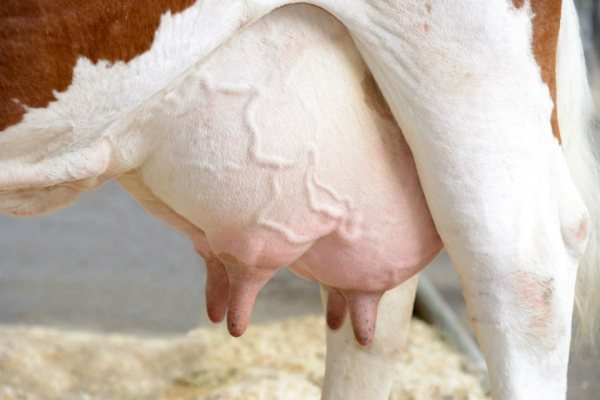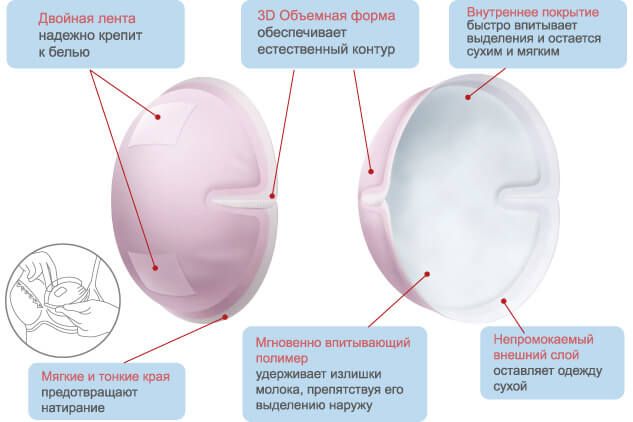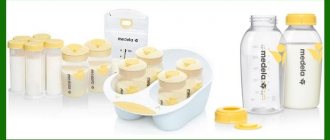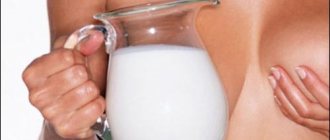Flushes of milk
The culprit is the same hormone oxytocin , which begins to be produced even before childbirth. It stimulates labor and is also responsible for the production of breast milk. A small emotional outburst, a baby crying in the middle of the night or thinking about him in the middle of the day, between household chores and chores is enough for oxytocin to be released - and milk begins to ooze from the breast .
In fact, the process of lactation - that is, the production of breast milk - begins during pregnancy. It has several stages. A woman’s body is preparing to feed a baby, her breasts become larger and swell, and in the last weeks of pregnancy colostrum may be released from the nipples. This is not milk as such. It appears later, approximately 2 to 5 days after the baby is born.
At this stage, the woman's breasts reach their maximum size and fill with milk at a very high intensity - this is called " hot flashes ". There may be several of them throughout the entire lactation period. During the flow of milk, the breasts become very sensitive, hot and even painful. A woman's overall body temperature may also increase. If you lightly squeeze your chest now, milk cannot spurt out - there is nothing surprising in this, because it is overflowing with it.
Some women and obstetricians recommend pumping during hot flashes. Otherwise, the milk may stagnate, and this threatens the development of such not very pleasant pathologies as lactostasis and mastitis. Thus, spontaneous leakage is a kind of protective measure of the body. It splashes out excess breast milk from the breast and thereby prevents the development of dangerous diseases that would definitely be of no use to a nursing mother.
Stages of lactation
The composition of breast milk continuously changes throughout the feeding period, constantly adapting to the needs of the baby. Conventionally, three stages of its “maturation” can be distinguished:
- Colostrum is a precursor to milk; in some women it appears even before birth, in others - 1-2 days after. Colostrum is a translucent yellowish liquid, rich in protein - it contains about 7%, while in the present it is only 4%, but its fat content is minimal. Colostrum helps to “tune” the baby’s gastrointestinal tract and helps clear it of meconium, the original stool.
- Transitional milk - replaces colostrum. This usually occurs 3-5 days after birth. The amount of fat in it is greater than in colostrum; it is opaque, white-yellowish in color. The arrival of transitional milk is accompanied by an increase in the volume of the mammary glands and an increase in body temperature.
- Mature milk – arrives at the end of 2-3 weeks. The percentage of protein and fat in it stabilizes, and production becomes regular with constant application to the breast.
In order for the lactation process to normalize, it is very important, especially in the first weeks, to put the baby to the breast upon request. The duration of the first feedings will be short, only 5-8 minutes, but do not worry - a few drops are enough for the baby in the first days of life. This mode allows the breast to “adapt” to the baby’s appetite, and milk will be produced in the required volume.
What can cause milk leakage in a nursing mother?

After the tide comes the stage of “mature” lactation, the process of self-regulation begins. The breasts become slightly smaller in size and significantly softer. Now it is clear how much milk the baby needs, and exactly the same amount is produced. The breasts swell again only if for some reason the feeding time was missed and milk accumulates in it.
It must be said that the timing of the onset of mature lactation is individual for each woman. It only takes a few weeks for one body to stabilize milk production. For other women, this period lasts up to several months. All this is completely normal and does not indicate any disorders in the body; there is no reason to consult a doctor. Spontaneous leaks are characteristic of this period - the formation of mature lactation. It can be provoked by :
- feeding the baby - when the baby sucks on one breast, milk leaks from the other;
- drinking hot drinks;
- sudden movement of the hand or body, especially shortly before the upcoming feeding;
- accidental pressure on the chest - for example, during night sleep;
- any positive emotions, thoughts about the child;
- as a response to the baby's crying.
There is no need to blame yourself for sloppiness and uncleanliness - you have absolutely nothing to do with it. As mentioned above, this is the work of the hormone oxytocin, although a woman cannot control its release. But below is what she can and should do to avoid getting into awkward situations.
Milk flowed but didn’t get into the can
Drops and streams of milk from the udder indicate the presence of the disease. It is called lactororrhea. It is considered a common disease.
The causes of fluid incontinence can be relaxation, reduction or paralysis of the sphincter (circle of muscles) of the nipple.
The answer to the question of why a cow’s milk leaks may be the occurrence of the following factors:
- injuries and inflammations in the udder;
- scar growth;
- tumors in the nipple canal;
- nervous system disorders;
- stress, excitement, fear, estrus;
- overheating or hypothermia of the animal.
You can notice the release of milk after the cow has returned from walking. In this case, the udder is not even completely filled, but liquid still flows out. Sometimes the drops are shown first.

But as soon as you start wiping the udder before milking or doing a massage, streams begin to flow, sometimes very wide. The nipple muscles do not try and cannot hold them.
How to stop milk from leaking out?

In order to save money at home, you can use pieces of a clean diaper or gauze folded in several layers instead. But such patches need to be changed as often as possible, and before each feeding, wash the breasts with clean warm water. Then bacteria will not have a chance, and your linen and clothes will always be clean.

It is important to know that milk leakage from the breast during feeding is natural and harmless . Even when the baby has already been weaned, discharge may continue for several months - for example, when pressing on the chest or under a hot shower. This is also normal.
Important
If leakage continues even six months after stopping breastfeeding, then you should see a doctor - there may be a hormonal imbalance.
Of course, spontaneous leakage of milk can be inconvenient, especially if it happens in public and the discharge is so copious that it shows through your bra and clothes. But it’s better to have an excess of milk than not to have it at all - after all, in this case you will have to switch to adapted formulas, which is not at all beneficial to the health and development of the baby.
Therefore, you should not be too embarrassed and worried - this is a completely physiological phenomenon that will soon pass. In the meantime, you just need to take better care of yourself and don’t forget about the inserts in your underwear - then no embarrassment will happen in public places or in front of your family.
8, total, today
( 196 votes, average: 4.65 out of 5)
Early breastfeeding: meaning, benefits for mother and child
How and when to start brushing your child's teeth
Related Posts
The first sign of change is soybeans

The idea of making milk from plants is not new. In China, soy milk has been prepared since at least the 14th century, most commonly used for tofu. The earliest mention of almond milk is found in a Baghdad cookbook from 1226. But in the West, until recently, almond and soy milk were known only to vegetarians and rare eccentrics. For example, Henry Ford was very fond of soy drink.
In 1956, the Plantmilk Society was founded in London. Its founder, Leslie Cross, then vice-president of the British Vegan Society, was particularly opposed to the cruelty of the dairy industry and wanted to find a substitute for cow's milk. His main task was to obtain protein in liquid form.
There were many experiments with cabbage, but in the end we settled on soybeans. The market was very small, a few hundred people, and the idea failed.
In 1981, Belgian food technologist Philippe Vandemoortele began using the new Tetra Brik packaging technology to sell soy milk. He was young and started the business literally in a garage. Vandermortele named his brand Alpro. Reviews about the product were contradictory at first. The local supermarket refused Vandermortele, but he did not despair. Today Alpro is owned by Danone, and its turnover in 2020 was approximately $239 million.
But soy's real triumph came in the late '90s, when a Colorado company called WhiteWave made a seemingly obvious discovery: if you put the product in the refrigerator next to cow's milk, sales began to increase. Her chilled soy drink Silk became a sensation. In addition, companies seized on emerging research at the time linking high cholesterol and heart disease.
Manufacturers of plant-based milk have begun to promote it as a healthy alternative to regular milk. Suddenly, soy became a product for everyone.
But the peak of its popularity was short-lived, largely due to its not very pleasant taste. Even modern types of soy milk, which add sugar and thickeners, taste and smell like beans.
In addition, in the early 2000s, evidence emerged that soy could be dangerous. It contains phytoestrogens - compounds similar to estrogen. They imitate the work of this hormone in the body. There were concerns that these substances would disrupt the hormonal system and make men more feminine. Clinical studies have shown that such fears are exaggerated. However, some still believe in them and even promote the theory that soy milk is part of a conspiracy to feminize men.
This trend is a reflection of today's food culture
Is plant-based milk a healthy substitute for cow's milk? This issue causes heated debate, which is important not only to theorists. In June 2020, a Belgian couple was found guilty of the unintentional death of a seven-month-old baby who was fed plant-based milk. Parents who owned a health food store believed that their baby was lactose intolerant. And they turned to homeopaths for help, not doctors.
There is also a lot of debate about whether to add vitamins to plant milk to make it more like cow's milk. Some people think this is unfair. Others refuse supplements because fortified foods are not certified organic.
Manufacturers are trying more to talk about what their products do not contain: vegetable fats, sugar, soy, gluten, GMOs, bisphenol. Sometimes this list is longer than the list of ingredients. Some companies even pride themselves on not adding carrageenan, even though this thickener, made from algae, is recognized as safe by the World Health Organization.
It's the inevitable culmination of today's troubled food culture. If we used to buy food depending on what ingredients it contains, now we look at what ingredients are missing.
Therefore, cow's milk is no longer considered so valuable. What people are now afraid of is not childhood malnutrition, but childhood obesity. “According to many scientists, the idea that children must drink cow’s milk is a fiction. And the belief that it makes you big and strong, too,” says Mark Kurlansky. — On the other hand, you cannot think that “bad” cow’s milk can be replaced with almond or soy milk. These are completely different products."
Cow's milk is no less healthy than before. It is rich in nutrients and is a good source of calcium, protein, riboflavin and potassium. This is not to say that this is a useless product.
However, the popularity of plant-based milk has little to do with its health benefits or even ethical considerations. “People may consider these criteria, but they are not the first ones,” says Julian Mellentin, director of New Nutrition Business, a research firm that studies food industry trends. 90% of plant-based milk consumers continue to purchase cow-derived products such as cheese and ice cream.
Our interest in plant-based milk stems from a collective fear that something is wrong with our bodies. That we are not as healthy and happy as we could (or should) be, and someone needs to blame it.
Many people find themselves intolerant to dairy products and gluten. Perhaps the growing mistrust of cow's milk is a symptom of a loss of faith in agriculture and nutrition. People have learned that nutritional advice is constantly changing. At first it was believed that saturated fats were killing us, but now the number one enemy is sugar. Eggs and nuts were once hailed as sources of bad cholesterol, but are now considered superfoods. Naturally, this causes a skeptical reaction to the words of experts. Although science works this way: new data appears, conclusions change.
But then who can say with certainty that blood type does not affect lactose tolerance or that carrageenan does not lead to unknown diseases? “Just because our new lactose intolerance is undetectable doesn't mean it shouldn't be taken seriously,” Mellenthin says. - It is not related to allergies, but to well-being. With something that helps improve it.” And it's hard to argue with that.











